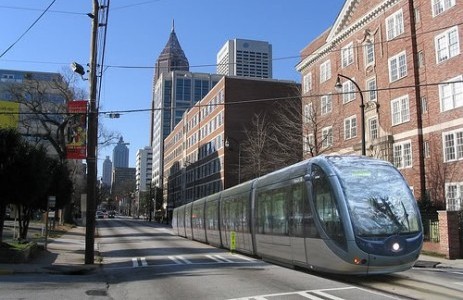 Atlanta was awarded $47 million last week for a new streetcar line.Image:GaloungerThe Obama administration is shifting federal transportation and housing funding away from its historical focus on sprawl-inducing highways and toward walkable, transit-friendly, mixed-use development. The work got started with the creation of the Partnership for Sustainable Communities, created in January, and is bearing fruit through a recent series of grants for local projects.
Atlanta was awarded $47 million last week for a new streetcar line.Image:GaloungerThe Obama administration is shifting federal transportation and housing funding away from its historical focus on sprawl-inducing highways and toward walkable, transit-friendly, mixed-use development. The work got started with the creation of the Partnership for Sustainable Communities, created in January, and is bearing fruit through a recent series of grants for local projects.
For the work to continue, it needs secure funding from Congress, and that’s the point of Sen. Chris Dodd’s (D-Conn.) Livable Communities Act. The bill would provide $4 billion for the Department of Housing and Urban Development to award to projects that fit the administration’s livability priorities — which would encourage cities, towns, and rural areas around the country to take a long hard look at smart growth design principles. The bill passed the Banking Committee in early August and is awaiting action in the Senate (which may take a while).
In Metropolis magazine, Karrie Jacobs laments that the act would provide incentives but not requirements for smart-growth style projects. “The approach is all carrot, no stick,” she says:
Like much of what comes out of the Obama administration, [the bill] is neither as far-reaching as its proponents would like nor as radical as its detractors claim.
… It offers a tantalizing preview of how the American landscape could change under an administration that cares about these issues. Someday we might have “complete streets” (conceived for all users, not just drivers), comprehensive regional plans, and saner ways for the elderly to get around. But the bill wouldn’t make any of those things happen. Not directly.
I don’t buy Jacobs’ worry that incentives alone can’t do much good, because the Partnership for Sustainable Communities has another ally — the millions of Americans who prefer to live in walkable neighborhoods.
There’s tremendous market demand for housing in such places. A 2004 National Association of Realtors survey [PDF] found that 55 percent of respondents prefer to live in smart growth-style neighborhoods rather than suburban ones. Yet car-centric development has dominated the construction industry for the last 50 years.
“When you look at the supply side, even a town like Seattle has at best 10 percent of its housing stock in a walkable urban environment,” University of Michigan real-estate scholar Christopher Leinberger told me a few months ago. “You’ve got huge pent-up demand and that pushes up prices.”
So even modest federal incentives, coupled with this demand, could make walkable urbanism more affordable for a lot of people.
Families in transit-friendly, mixed-use neighborhoods tend to spend less on transportation than households in autocentric suburbs, leaving more money for rent or mortgage payments. But housing in those same neighborhoods will still be unaffordable for far too many people.
One of the most transformative things the administration could do is direct federal mortgage underwriters to reward location efficiency and energy efficiency in their lending standards. These ideas are theoretically sound — homeowners spending less on auto maintenance and energy bills are safer bets for lenders. But they require careful implementation, given the shaky condition of the mortgage market.
The Senate bill settles for authorizing studies on these tools. As Jacobs notes, it’s probably time to move beyond research on green lending — we’ve got that already — and put it into practice.



